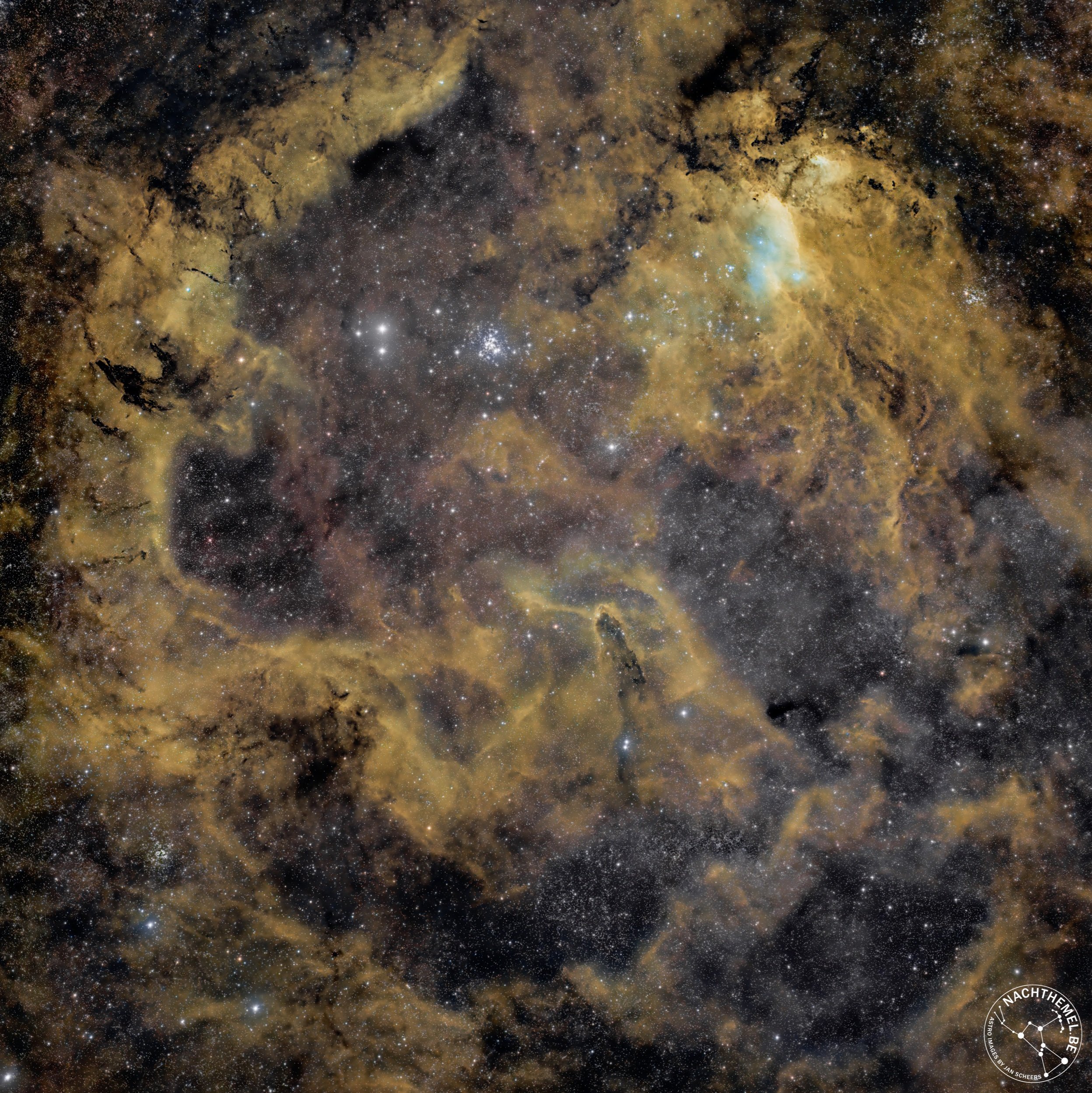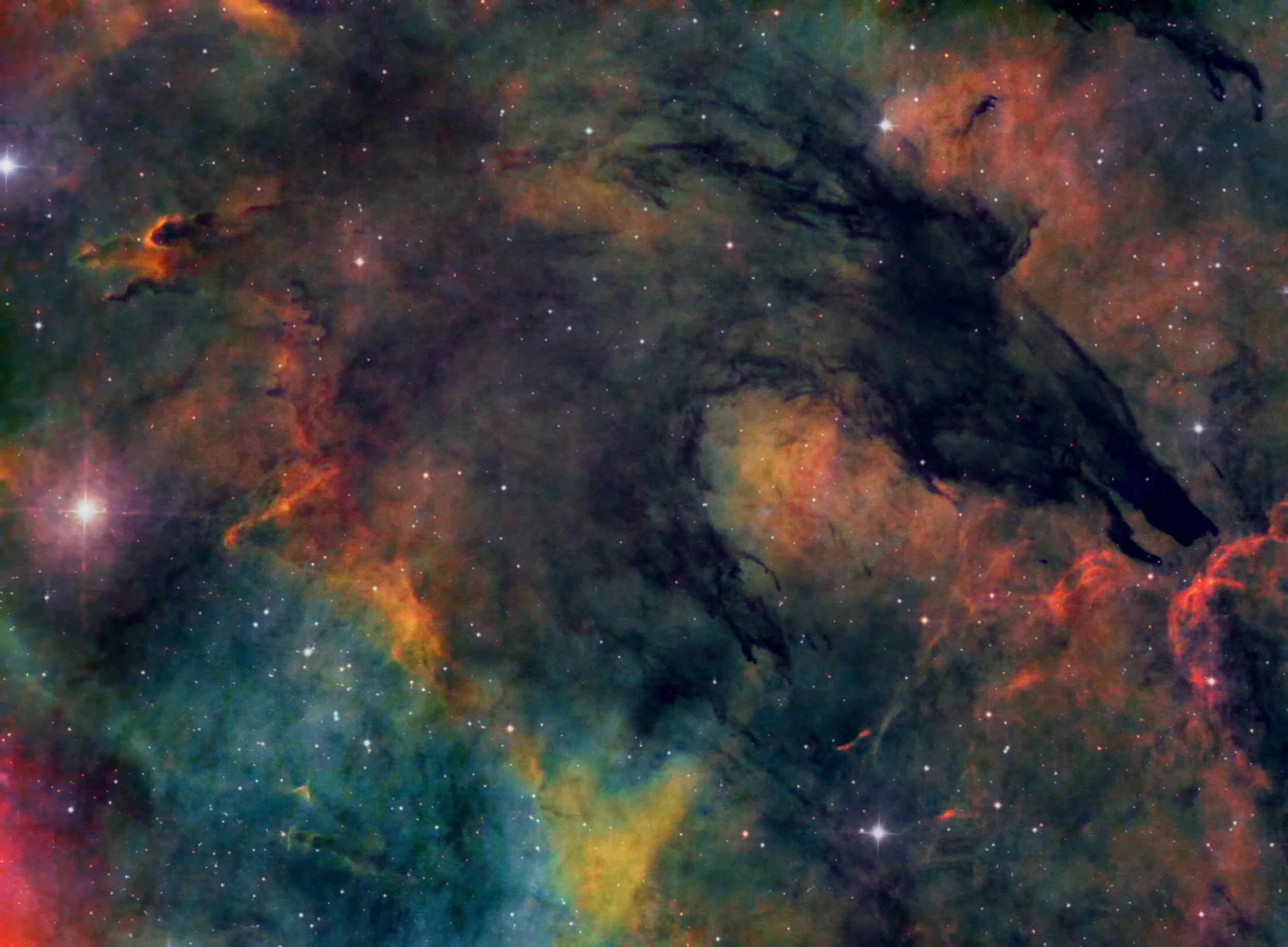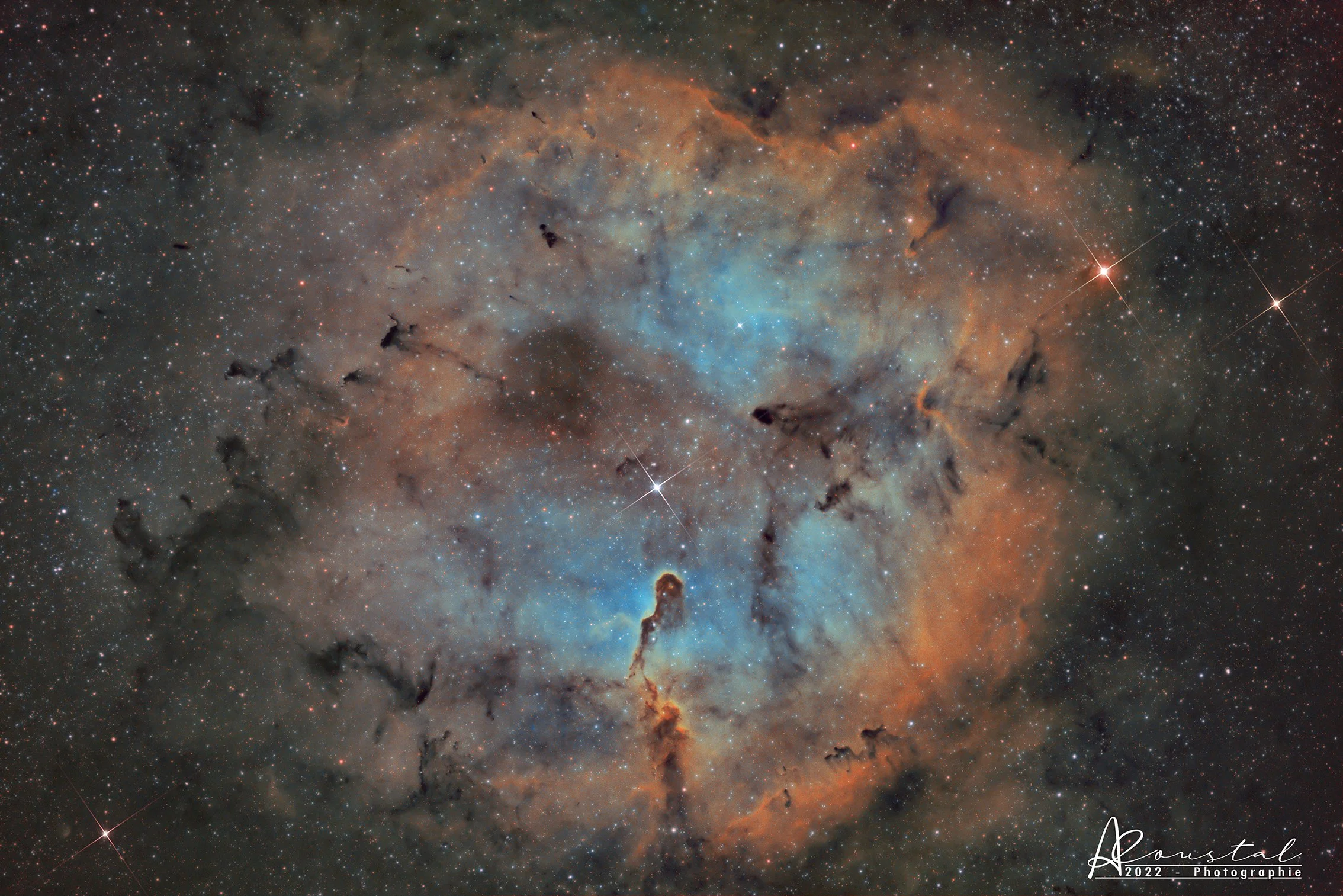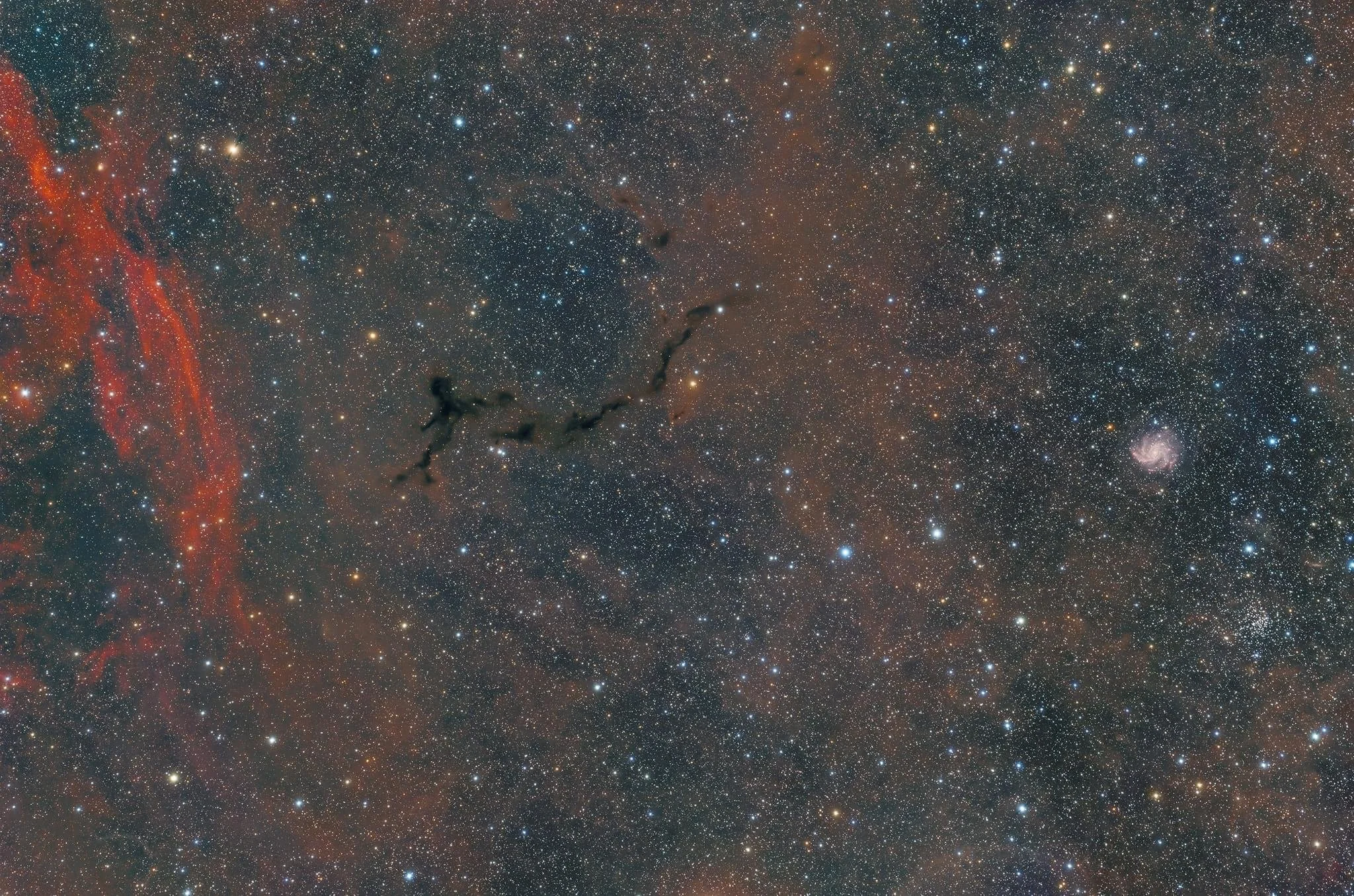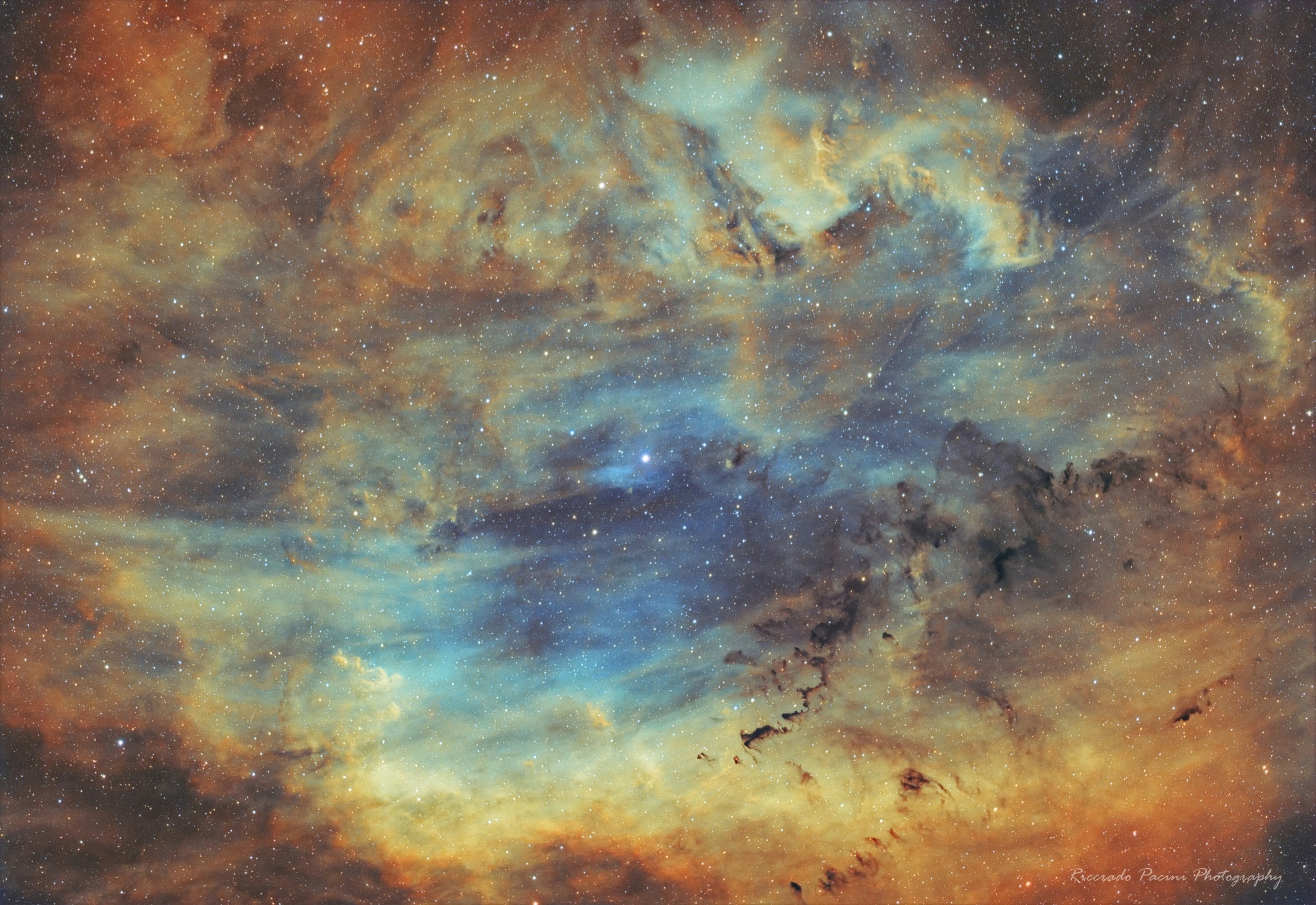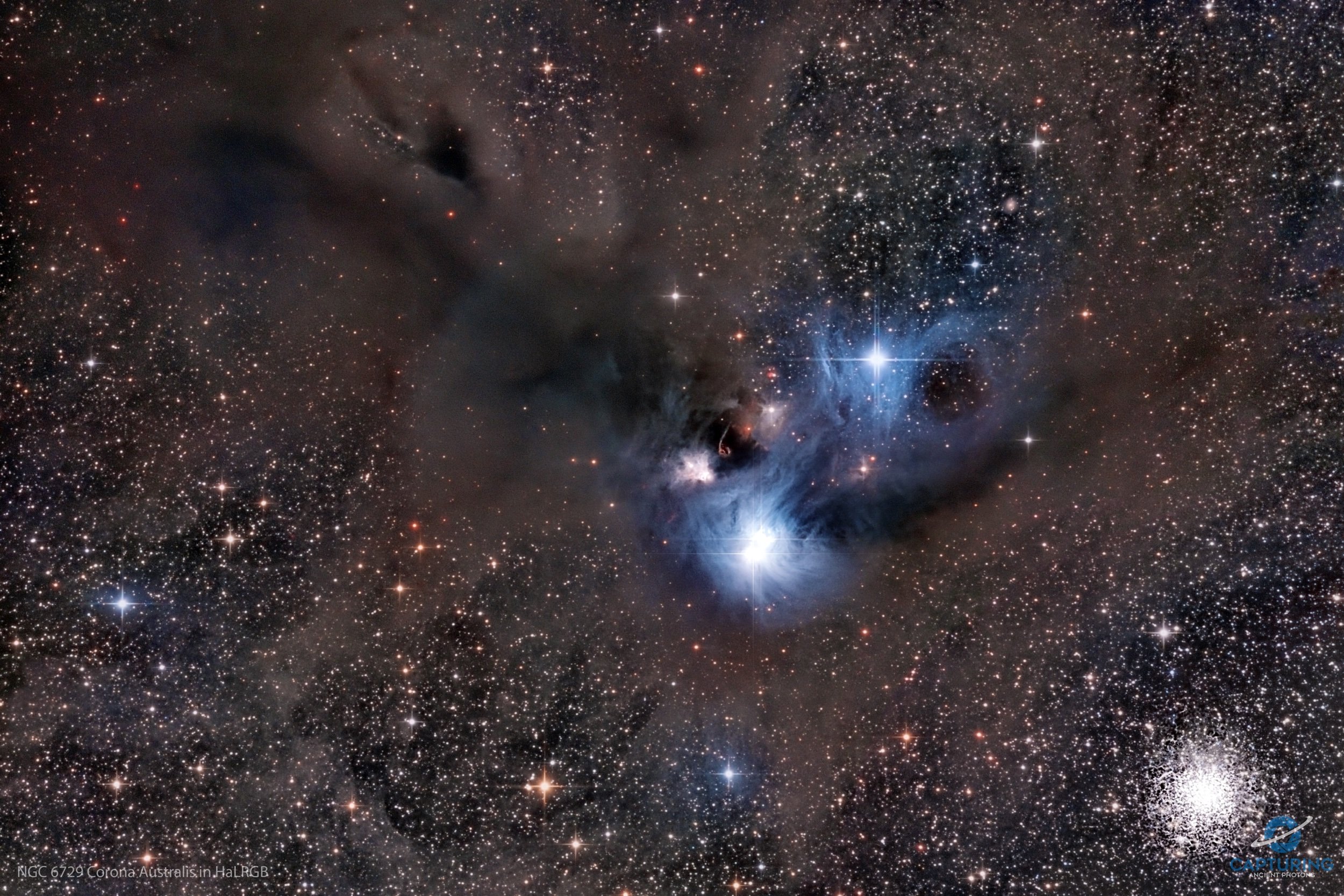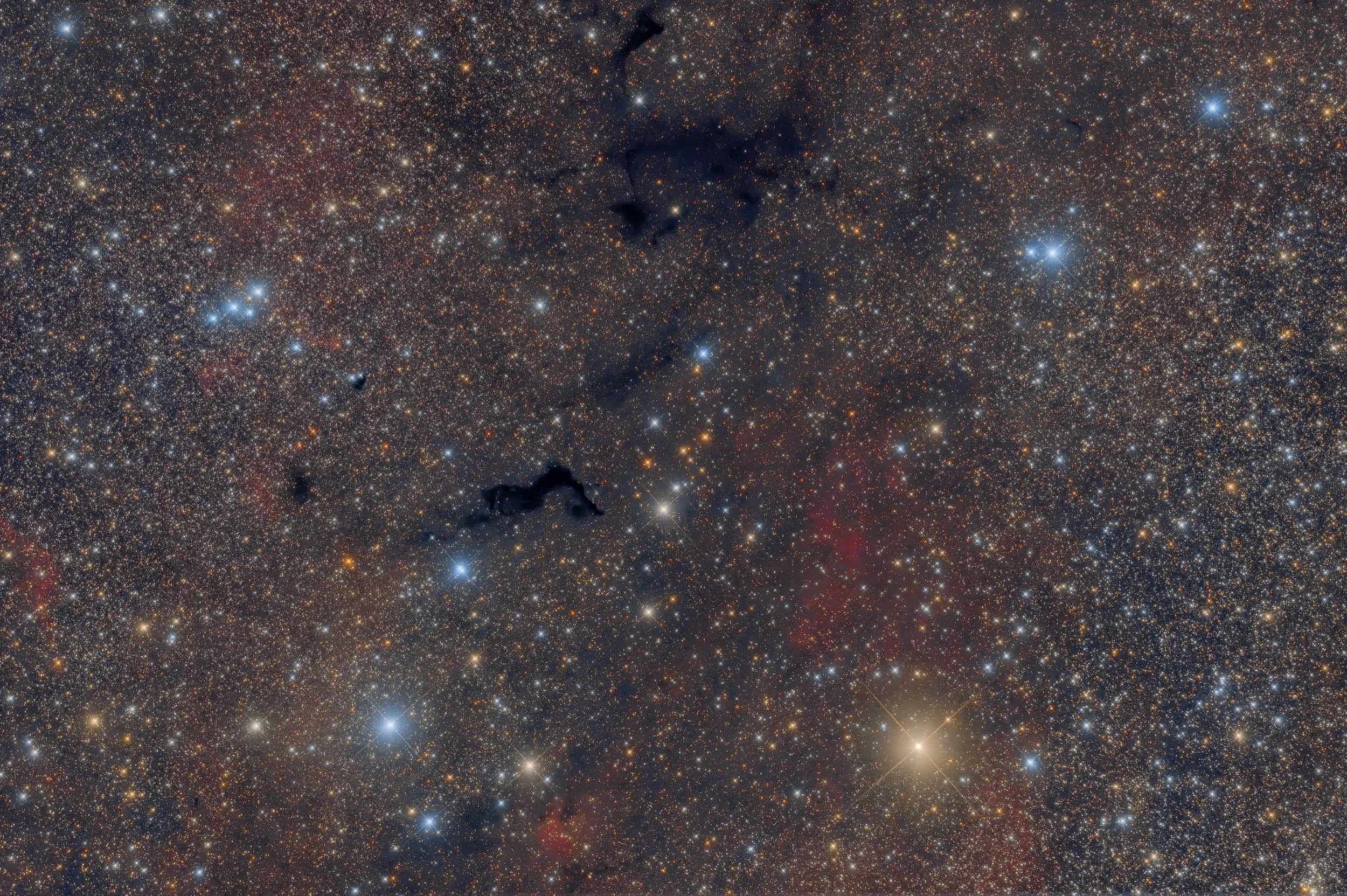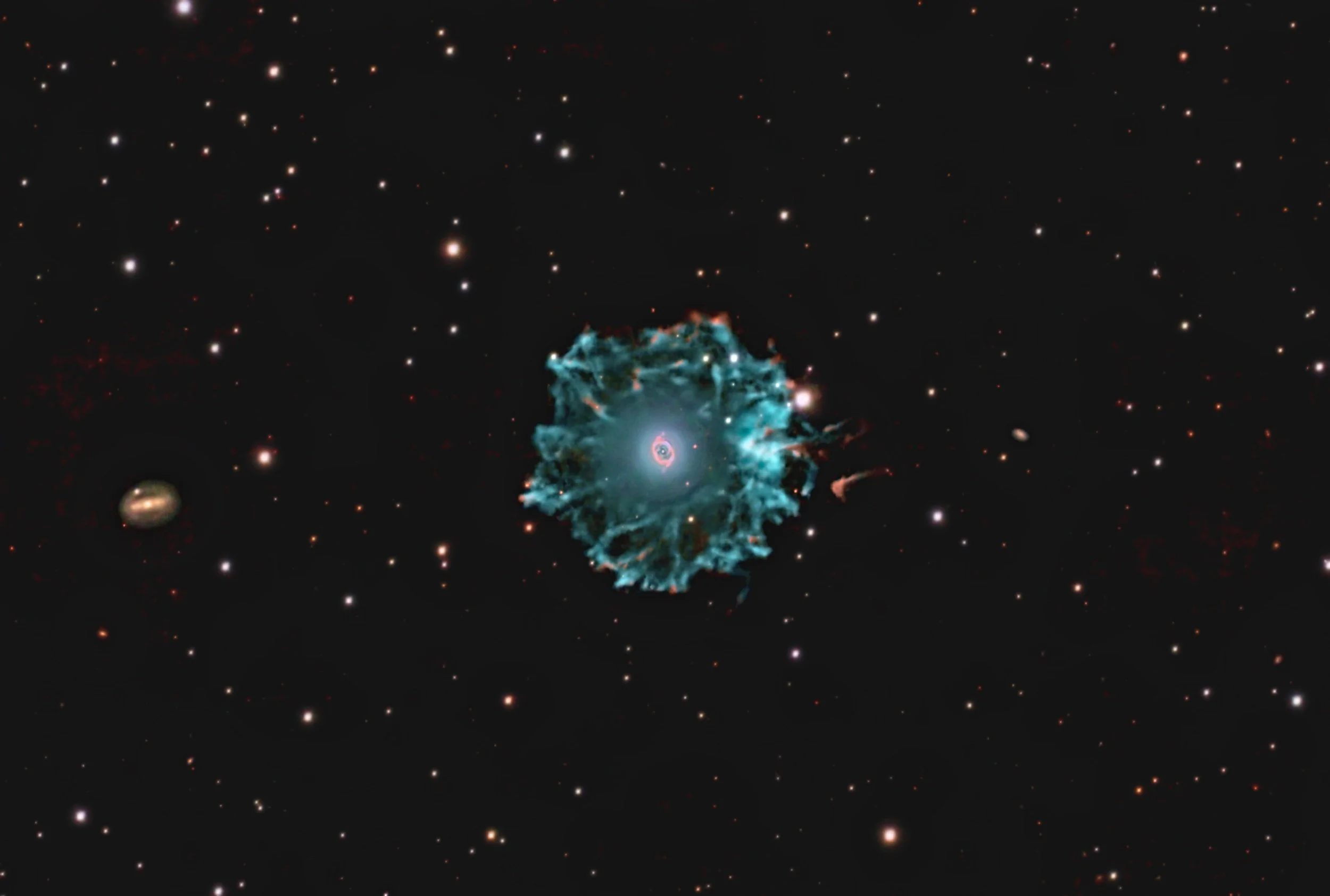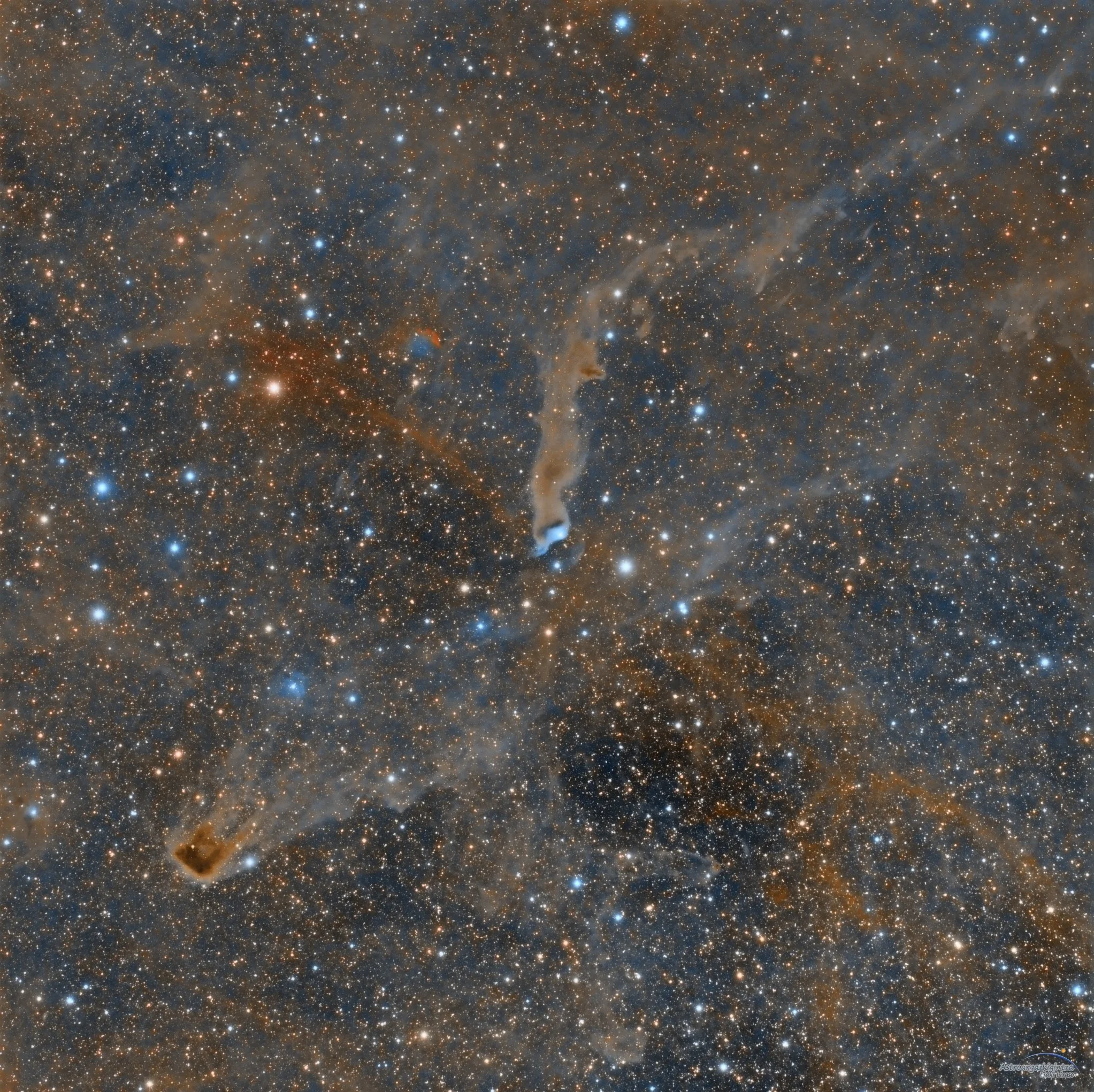
AAPOD2 Image Archives
IC 4685
Image Description and Details : IC4685 can be found in the constellation of Sagittarius, very close to and often shown as part of the Lagoon Nebula. This area is rarely imaged on its own because of the more common photographic targets of M8 (Lagoon) and M20 (Trifid) being much more dominant in this area. The estimated distance is about 4000 light years away. The area of the image contains both emission and reflection nebulae and the open star cluster NGC 6546. Imaging telescope: Takahashi FSQ106ED Imaging camera: QSI 6120i Mount: Takahashi EM 400 Temma 2M Guiding telescope: QHY Mini Guide Scope Guiding camera: QHY CCD QHY 5L II Focal Extender / Reducer: 0.73X Capture Software: Sequence Generator Pro, PHD 2 Processing Software: Astro Pixel Processor, PixInsight, Topaz DeNoise, Photoshop Filters (1.25"): Astrodon SII 5nm, Ha 5nm & OIII 5nm Accessories: ATIK EFW2, SeleTEK2 controlling Robofocus Focuser. Dates: 27th Jun - 10th July 2022 Frames: Astrodon SII 12 x 15' Astrodon Ha 12 x 15' Astrodon OIII 20 x 15' Total integration = 11 Hours
Copyright: Brendan Kinch
RCW 113: a beautiful H II-region in Scorpius
Image Description and Details : RCW 113, also called Gum 55, is a huge emission nebula (H II-region) in the constellation Scorpius, located in the neighboring Sagittarius Arm of the Milky Way. Its core ionising open cluster NGC 6231 is part of young, bluish stars known as the Scorpius OB1 association. This Sco OB1 association contains many star-forming areas with young, energetic stars of spectral class O & B. In this field of view other interesting deep sky objects are visible. The two bright stars to the left of NGC 6231 are zeta1 and zeta2 Scorpii. The Prawn Nebula (upper right, with blue hues), also known as IC 4628, is an emission nebula around 6,000 light-years from Earth. To the right of IC 4628 there is another open cluster NGC 6242. The Wolf or Fenrir Nebula (SL-17), @ 10 o’clock position in this image, is a dark nebula of dust and gas hiding the background stars. The Dark Tower (SFO 82) is the prominent bright-rimmed cometary globule, about 1.5 degrees away from NGC 6231 and Zeta Scorpii. The shape of this massive structure of cosmic dust resembles a dark tower emerging from the star field background. Most of these objects lie at a distance between 5,300-6,000 light-years from Earth. Image acquired with the Takahashi FSQ-106ED refractor and FLI PL16803 camera from Telescope Live in Heaven's Mirror Observatory, Australia. Total integration time: 300 minutes SHO: 10 sub-frames of 600s with each narrowband filter (SII, H-alpha and OIII). Dataset Telescope Live. Processing with Astro Pixel Processor, Photoshop CC with AstroPanel Pro, Astronomy Tools, Topaz Sharpen AI and NoiseXTerminator plug-ins.
Copyright: Jan Scheers
SL-17 The Dark Wolf Nebula
Image Description and Details : SL17 ( Sandqvist and Lindroos 17) is located in the constellation of Scorpius around 6,230 light years away. It’s a star forming region dominated by hydrogen emissions but also the very dark nebula which resembles a wolf and blocks out the stars beyond it. Sidereal Trading CF 10" Newtonian Reflector F5 ZWO ASI1600mm pro Skywatcher EQ6-R Astrodon 3nm Ha, Sii & Oiii 180 x 240s, Astrodon RGB 44 x 120s Shot from 22nd May 2022 through to 6th July 2022 Total Integration: 13hr 28min
Copyright: Anne-Maree McComb
IC 1396 the Elephant Trunk
Image Description and Details : Camera ZWO - ASI 2600 MM Pro Refractor TS 76 x 342 EDPH Skywatcher EQ8 Filter Antlia 3nm pro HA : 20 x 300s B1 S2 : 6 x 300s B1 O3 : 20 x 300s B1 Sky bordle 8 Personal observatory Pixinsight - Uwe AstroTools
Copyright: COUSTAL Eric
Barnard 150
Image details:
This is Barnard 150 is a dark nebula visible in the constellation Cepheus. It is also known as the Hippocampus Nebula due to its shape.
Also in this image is Galaxy NGC 6946, nicknamed the Firework Galaxy, is a spiral galaxy seen almost face-on. Straddling the Cygnus and Cepheus constellations, as well as the NGC693 cluster.
Details:
Takahashi fsq-85-EDX
ZWO ASI2400MC-PRO camera
ZWO ASI290mm guide cam
Ioptron CEM70 mount
ZWO Asiair pro
IDAS NBZ Filters
Pixinsight - astro pixel processor - photoshop
Integration: 15h35
Copyright: Christophe Vergnes
The clamshell nebula
Image Description and Details : The clamshell nebula in Cygnus Sh2-119 Is a large complex of emission nebulae in the constellation Cygnus. The bright star at the center is 68 Cygni, a 5th magnitude star responsible for ionizing the surrounding gas. Estimated tonbe 2200 light-years from Earth. This image is the result of 4 night during which I collected 24h of data Using ultranarrowband filter From bortle 9 backyard 96 x 300sec exposure for each filter Gain 121 tenp. -5°C 40 dark calibration files 20 flat calibration file per filter per session
Copyright: Riccardo pacini
NGC 6729 Corona Australis in HaLRGB
Image Description and Details : NGC 6729 is a reflection/emission nebula (star-forming region) located some 424 light-years away in the constellation of Corona Australis (The Southern Crown). It is part of one of the closest stellar nurseries to Earth. The Corona Australis Molecular Cloud is a dusty dark molecular cloud just north of one of its two brighter stars Beta Coronae Australis. Within it are stars at the earliest stages of their lifespan. 7 x 10min Ha and 85 x 5min RGB subs @-10C were taken over 5 nights for a total integration time of about 8.3 hrs. Equipment used: Skywatcher 10" f4 Newtonian 250P Skywatcher F4 Aplanatic Coma Corrector Skywatcher NEQ6 Pro Hypertuned by Astronomy Academy Perth ZWO ASI2600MM Pro Cooled Camera Primaluce Sesto Senso2 Electronic Focuser William Optics Uniguide 50/200mm guidescope ZWO ASI290MM Mini Guide Camera ZWO Electronic Filter Wheel Antlia Pro 36mm unmounted filters Rollon rolloff modified shed observatory Bortle 5 Data acquisition software: NINA Astronomy Software Processing software: PixInsight and Photoshop CC
Copyright: Capturing Ancient Photons
Jupiter, IO and GRS
Image Description and Details : A long awaiting window of good seeing finally transpired over my home observatory in Pembroke Pines, Florida early on Sunday morning July 3rd. The image is the result of 120 seconds capture at 13ms exposure, and stacked the best 46% of the frames. Europa and the Great Red Spot adding to the field of view. Hardware used: Celestron C11 Edge HD QHY 5-III 462c Camera ZWO Atmospheric Dispersion Corrector TeleVue 2.5 Powermate Primalucelab Eagle2 Pro Seeing conditions 4/5 Captured at 10:00 UT 07/03/2022 CM1=122.5 CM2=28.5 CM3=296.4 Earth distance at time of capture - 4.790 AU
Copyright: Varney Observatory
Barnard 174 complex
Image Description and Details:
Barnard 174 (=LDN1164) is a very dense dark nebula, which absorbs starlight behind the nebula. Infrared observations show many young stars in this region. Thus, B174 is an active star-forming region. Barnard 174 is a dark nebula in the constellation Cepheus. Dark nebulae or "fog" as they are sometimes called are clouds of cold gas, at temperatures near absolute zero (-273°C), located in cold, dense areas of larger molecular clouds . Their thickness obstructs the visible spectrum of stars or anything in its path. Only infrared and x-ray observations can be made through fog. The dark color is due to microscopic dust particles coated in frozen carbon monoxide and nitrogen, which block visible light. Equipment: TAKAHASHI Epsilon 130D Camera Zwo ASI2600MC CEM120 ioptron mount Acquisitions with NINA Pixinsight and Photoshop
Copyright: LAMAGAT Frédéric
NGC 6543 - The Cat's Eye
Image Description and Details : NGC 6543 is a planetary nebula ~3,300 light years away in the Draco Constellation. This was shot from Bortle 8 Dallas-Fort Worth over eight nights in June 2022. Equipment: Celestron EdgeHD 1100 at full focal length 10Micron GM1000HPS mount ZWO ASI6200MM-Pro main camera Chroma LRGB and 3nm Ha and O3 filters
Integration: 25 hrs
Copyright: Timothy Martinh
VdB 152 and its dusty field
Image Description and Details : Located in the Cepheus constellation at 1400 lights-years, Van den Berg 152 is a blue reflection nebula near the edge of a large molecular cloud with full of interstellar dust and a star in the embedded region (BD+69 1231) giving to the edge of the molecular cloud the blue color. LDN1221 and a large tail of dust crosses the field like a comet. Image acquired through Takahashi FSQ-106EDX3 on EM-200Temma2M and Andor Apogee U16M / AFW-50-7S ccd. Guiding: FS-60CSV, QHY-5, PHDguiding. Processing by PixInsight Core 1.8. Date: 27th of June 2022.
Copyright: Iñaki Lizaso



